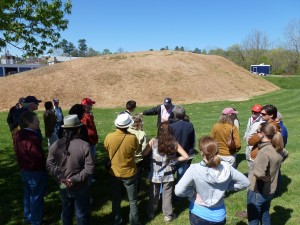
Practitioners, scientists, and Indigenous community members from ten different countries met at the University of Georgia to share their work on indigenous revival and the conservation of sacred sites (5-7 April 2012). As part of the inauguration of the Neothropical Montology Collaboratory led by Fausto Sarmiento, most of the work focused on sacred mountains with examples drawn from around the world and in particular the Andes.
High altitude archaeologist Constanza Ceruti shared her work on the interpretation of sacred places of the Inca as interpreted through investigating mummies and ceremonial sites above 5000m across South America. Although the Inca civilization no longer exists mountains are still sacred to many of the living Andean cultures today.

Superintendent Dorothy Firecloud explains about managing competing claims and interests between climbers, residents and the Indian tribes at Devils Tower, National Monument in Wyoming. Photo: B. Verschuuren.
In Ecuador for example, eleven sacred mountains are known to embody the spiritual heartland of the Atawalakuna. Cesar Cotacachi, an Indigenous Kichwa Otavelano person explained the importance of regulating tourism and restoring the natural integrity of these sacred natural places in relation to the well-being of all Otavelano people.
The Sacred Natural Sites Initiative delivered a key note address outlining the need for collaboration between conservationists, scientists and NGOs in support of custodians that are protecting and managing their sacred natural sites. Putting the control over conservation of sacred natural sites in the hands of local and indigenous peoples also provides new perspectives on the role of science.
According to Bern Guri, indigenous ways of knowing are themselves sciences. He made the point that these “indigenous sciences” are at the basis of local communities way of life and should be the starting point of any conservation work or scientific work on sacred sites at the community level. Himself a Dagara person from Ghana, Bern presented CIKOD’s work on saving the sacred places of the Tancharra community (Tanchara meaning “in between mountains” in Dagara language).

The conference participants listen to scholar and lawyer Mr. Jace Weaver, who is also a member of the Cherokee Eastern Band. Here he is seen explaining the significance of the mound that once accommodated part of the traditional settlement of Mikwasi. Photo: B. Verschuuren.
Community and Archaeologist Ben Steere presented his work for the Eastern Band of Cherokees who’s territory is close to where the conference was being held. This band employs archaeologists to regain information on their past in order to carefully restore the physical and intangible importance of their sacred places. Cherookee leaders guide the work and are closely involved with the activities on the ground themselves leading to what is perhaps best described as community or participatory archaeology.
The party continued on to visit the Cherokee Museum and the Cherokee interpretative trail at Chattahoochee National Forest. The trip came to a close at the mound which is regarded the sacred origin site of the Cherokee. This particular mound was lost to the Cherokee as the area came under the laws of South Carolina. It was later ploughed down for farming in the 1920’s and was bought by the Cherokee Eastern Band for approximately 3 million dollars in 1996 who are now keeping it safe from further damage.






